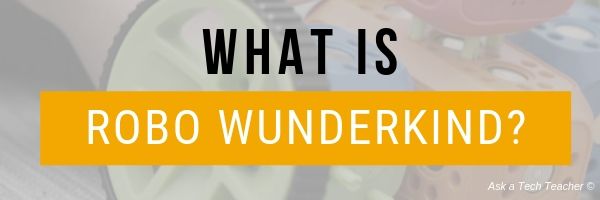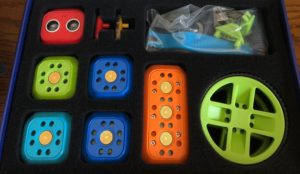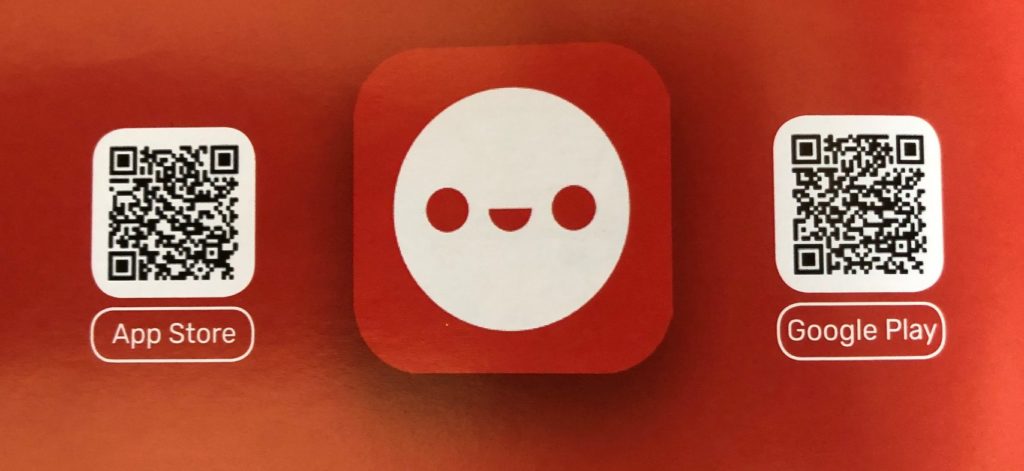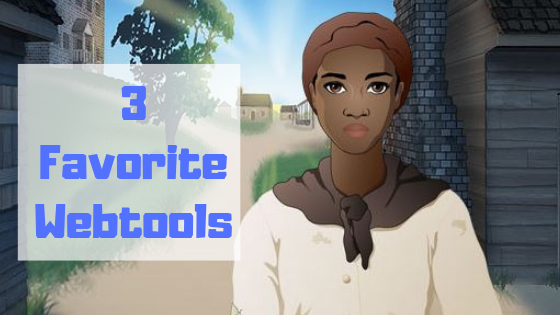There are a lot of options if you want to bring programmable robots to your classroom. One I discovered this summer and have fallen in love with is Sunburst’s Robo Wunderkind. It is a build-a-robot kit designed to introduce children ages six and up to coding and robotics as well as the fun of problem-solving and creative thinking. The robot starts in about thirty pieces (there are so many, I didn’t really count them). You don’t use all of them in one robot, just pick those that will make your robot do what you want. The completed robot can move around on wheels, make sounds, light up like a flashlight, sense distance and movement, twist and turn, follow a maze, or whatever else your imagination can conjure up.
But don’t be confused. The goal of this kit is as much about building the robot as having fun exploring, experimenting, and tinkering.
What is Robo Wunderkind
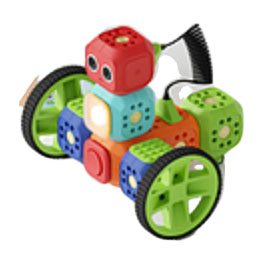 Robo Wunderkind is an award-winning robotics kit that lets young children build an interactive robot and then program it to do what they want. It can be used at home, in school, or as an extracurricular tool for teaching STEAM disciplines (science, technology, engineering, art, and math). The box includes a bunch of color-coded parts, a few instructions, and a whole lot of excitement. The builder’s job is to connect the pieces into the robot of their dreams, program it to do what they need, and then start over.
Robo Wunderkind is an award-winning robotics kit that lets young children build an interactive robot and then program it to do what they want. It can be used at home, in school, or as an extracurricular tool for teaching STEAM disciplines (science, technology, engineering, art, and math). The box includes a bunch of color-coded parts, a few instructions, and a whole lot of excitement. The builder’s job is to connect the pieces into the robot of their dreams, program it to do what they need, and then start over.
Fair warning: This robot doesn’t look like the famous humanoid robots of literature–C3PO or Marvin the Paranoid Android (from The Hitchhiker’s Guide to the Galaxy), with arms, legs, and a head. It’s more like something you might construct from Lego Mindstorm though easier to set up, build, program, operate, and decode. I’ve used both and hands down would start my younger students with Robo Wunderkind. I agree with Tech Crunch when they say:
“You won’t build a robot as sophisticated as a robot built using Lego Mindstorms. But Robo Wunderkind seems more accessible and a good way to try robotics before switching to Arduino and Raspberry Pi when your kid grows up.
How to get started
If I were to rate myself with robotics, I might be closer to a 5 than a 10. I approach the task of building my own with a small degree of trepidation. I tell you this because, if I can build a robot with this system, any six-year-old (and up) can.
To get started, I needed a mobile device (like an iPhone, Android phone, or an iPad–the latter is recommended), a Bluetooth connection, and a risk-takers mentality. That’s it! No plugs, electricity, logins, registrations, software, or magic codes. The kit I received from Sunburst included all the basic pieces like wheels, sensors, motors, a cable, connectors, and lights.
I started with what’s called the Main Block–a big orange rectangular shape with a battery, CPU, accelerometer, and a speaker. Everything else will be attached to it. Since it needed to be charged, I plugged it in and downloaded the two apps while I waited:
- Robo Live
- Robo Code
Once the Main Block was fully charged, I activated Robo Live, planning to complete one of its starter projects. The first step was for the app to recognize my Robo, which it didn’t. Turns out, I needed a quick firmware update, delivered via WiFi. That done, I started building the Driver project detailed in the Robo Live Workshop. It couldn’t have been easier. It listed all of the required parts and how to connect them. When I did this properly, the app beeped, like a congratulations. When the project was completed, I could swivel the 3D image and compare it to what I had built.
Spot on.
The process was quick, intuitive, and easy to understand. The connections between the parts are snug–no danger that they will disconnect.
Robot built, I moved on to the first app, Robo Code, where I program my robot to do something clever. Robo Code simplifies this activity by placing all of the coding tools at the bottom of the screen. All I had to do was drag-and-drop, connect them the way I’d like, customize where that was available like changing colors or making a light brighter or dimmer, and then test it with the Go button. When I got stuck (once–really, only once), there was a help button that explained what each icon means and what the underlying choices provide.
After running through a few more sample programs, the concepts snapped into place. From then on, I could build the robot quickly and program it to do a wide variety of simple actions.
Sunburst’s Robo Wunderkind Education Robotics Kit is robust with plenty of projects and robot parts to entertain students. The Advanced Upgrade Kit includes six more parts similar to what is found in the Education Kit–like a light sensor, motion sensor, LED display, and RGB LED. This is perfect for longer robotics programs and/or older students.
Suggestion: I started on my iPhone but quickly switched to my iPad. The code symbols are a bit small for a smartphone screen and become hidden under the iPhone’s lower coping.
The apps
Two apps are recommended to get started–Robo Code and Robo Live. These can be located quickly in the App Store or Google Play by scanning the QR code included in the instructions:
Go ahead–scan the image above on your smartphone or tablet to get one of the apps. I’ll wait. Done? OK. With these two apps, students can build predesigned projects as well as customized projects that they invent themselves.
Robo Code
Robot Code allows students to code everything from simple to complicated as they bring their robot to life. Its visual drag-and-drop interface, similar to other coding apps students have probably used (like Scratch or Lightbot), makes coding Robo Wunderkind quickly accessible. With this app, students can build a flashlight, a distance meter, a distance alarm, an obstacle avoider, and a driver.
Robo Live
Robo Live lets students control the robot they’ve already built in real time using easy drag and drop functions located on the app’s dashboard.
Robo Wunderkind Curriculum
The Robo Wunderkind Curriculum is fifty+ hours of activities that teach and reinforce core robotics skills. Lessons are each about five hours and cover topics like road safety, math, art, and nature studies. There’s also a separate set of activities for afterschool programs, summer camps, and workshops. The curriculum includes a comprehensive teachers’ guide that trains educators in the Robo Wunderkind robots, the apps, the projects, and the activities. Each lesson is categorized according to its focus and includes the difficulty level, goals, vocabulary, materials required, activity stages, big ideas, age level, steps, and expected learning outcomes. There’s also a helpful Student Journal available so students can take notes, review, quiz themselves, and track their progress.
The Robo Wunderkind Curriculum is aligned with Common Core Math, Reading, Writing, and Speaking and Listening Standards; ISTE; CSTA Computing systems and Algorithms & Programming Standards; and NGSS Standards.
What I really like about Robo Wunderkind
- It’s Lego compatible. With Lego adapters (most sold separately), kids can build a hybrid robot of Robo Wunderkind modules and Lego bricks.
- It’s not one piece. You build your own robot so each student’s is different.
- Module parts are color coded according to their actions so you won’t confuse connectors with sensors.
- App instructions are very clear. They show exactly what to put where and the app pings at you when it’s done correctly. The ability to rotate it in 3D–I can’t overstate how useful that is.
- The robots aren’t just for play. For example, I made a flashlight–a torch–with a green light, and it works magnificently.
- Just to spotlight how intuitive Robo Wunderkind is, some of the projects took me less than five minutes to complete.
- It comes in German, Swedish, and English–excellent.
Who will love this robot
- kids who love Legos
- kids who think outside the box
- kids who love fiddling with mobile devices
- kids who like remote controlled toys but always want them to do something they aren’t designed to do
- teachers looking for clever STEAM and STEM projects
***
If you like Legos but wish your creations moved, talked, and could run through a maze with you, you will love Robo Wunderkind.
Want a little more? Here’s a clever video:
Jacqui Murray has been teaching K-18 technology for 30 years. She is the editor/author of over a hundred tech ed resources including a K-12 technology curriculum, K-8 keyboard curriculum, K-8 Digital Citizenship curriculum. She is an adjunct professor in tech ed, Master Teacher, webmaster for four blogs, an Amazon Vine Voice, CSTA presentation reviewer, freelance journalist on tech ed topics, contributor to NEA Today, and author of the tech thrillers, To Hunt a Sub and Twenty-four Days. You can find her resources at Structured Learning.

